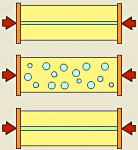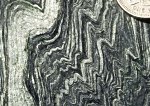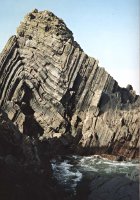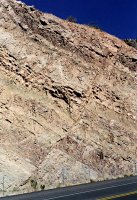

Click on an icon to see a larger image.
 When strata are caught in the vice of converging tectonic plates they respond
by deforming. Rocks can deform in many different ways. They can break with
the formation and movement along breaks - called faults. Or they can distort
in various ways.
When strata are caught in the vice of converging tectonic plates they respond
by deforming. Rocks can deform in many different ways. They can break with
the formation and movement along breaks - called faults. Or they can distort
in various ways.
 Active faulting is the main way earthquakes are generated but for every active
fault there are hundreds (or thousands) of faults which have moved in the
geological past and now lie dormant (the thrust faults of the Moine Thrust
Belt are examples
of dormant faults). The chief thing about faulting is that all the deformation
is taken up in a narrow zone with the surrounding rocks only disturbed by
being moved.
Active faulting is the main way earthquakes are generated but for every active
fault there are hundreds (or thousands) of faults which have moved in the
geological past and now lie dormant (the thrust faults of the Moine Thrust
Belt are examples
of dormant faults). The chief thing about faulting is that all the deformation
is taken up in a narrow zone with the surrounding rocks only disturbed by
being moved.
 Another common way that layered rocks deform is by folding. You can do this
yourself with a thin plank of wood. If you push the ends of the plank together
it will warp - or fold (of course if you push hard enough then the plank can
break - congratulations - you've made a fault!). To make folds in this way
(called buckling) the role of layering is critical - no layering and something
else happens.
Another common way that layered rocks deform is by folding. You can do this
yourself with a thin plank of wood. If you push the ends of the plank together
it will warp - or fold (of course if you push hard enough then the plank can
break - congratulations - you've made a fault!). To make folds in this way
(called buckling) the role of layering is critical - no layering and something
else happens.
 If a rock has no layering and is simply homogeneous (rather like a pat of
butter), if it's squeezed it will just thicken up. If a pat of butter is warm
enough you can do this. You can quantify the amount of strain by tracking
how the butter pat becomes thick or less wide. If you stamp a circle on the
surface of the butter and then distort it, notice that the circle becomes
an ellipse. In strata originally circular markers will become ellipses as
the rock strains too. This is also a way in which the amount of strain can
be charted.
If a rock has no layering and is simply homogeneous (rather like a pat of
butter), if it's squeezed it will just thicken up. If a pat of butter is warm
enough you can do this. You can quantify the amount of strain by tracking
how the butter pat becomes thick or less wide. If you stamp a circle on the
surface of the butter and then distort it, notice that the circle becomes
an ellipse. In strata originally circular markers will become ellipses as
the rock strains too. This is also a way in which the amount of strain can
be charted.
The various types of rock response to deformation can be found in NW Scotland. but why the differences?
One of the most important things governing how a rock will respond is its composition - not only what it is made of (types of grains) but also how they are arranged (layers or random).
 Then there are the conditions under which it is deformed. The most important
of these are pressure (i.e. how deep they were when they were being deformed)
and how hot. Depth is important because breaking rocks creates new volume
(voids). The further down you go the harder it is to do this - so most faulting
in geology is limited to the top 10 km or so in the Earth. There's still another
25 km of crust beneath this in most continents, and over 6000km to the centre
of the Earth. So what influences how these deeper rocks deform?
Then there are the conditions under which it is deformed. The most important
of these are pressure (i.e. how deep they were when they were being deformed)
and how hot. Depth is important because breaking rocks creates new volume
(voids). The further down you go the harder it is to do this - so most faulting
in geology is limited to the top 10 km or so in the Earth. There's still another
25 km of crust beneath this in most continents, and over 6000km to the centre
of the Earth. So what influences how these deeper rocks deform?
Temperature. The hotter a material in general, the weaker it becomes (take common house-hold materials like chocolate or butter). In geology the a critical point for becoming weaker is passed when a rock reaches 70% of its melting point (measured from absolute zero). As this varies from material to material, the temperature dependence on rock strength is strongly linked to rock composition. Minerals like halite (rock salt) can distort easily under geological conditions at temperatures of less than 100C. In contrast granite or quartzite will need to be at temperatures in excess of 400C to be anything like as weak.
 And the final controls on how a rock will deform depend on how the deformation
is applied (or how the sample is loaded in material science terms). Rocks
respond differently if they are extended or compressed. Further, the amount
of load can control the response. High stress (lots of force per unit area)
tends to break a rock while a low stress may result in a slower distortion
. The other chief control is how quickly the rock is distorted (strain rate).
Do it quickly and the rock is more likely to break, do it slow and the rock
will distort. Again there are plenty of household materials that respond in
the same way (e.g. a plastic ruler).
And the final controls on how a rock will deform depend on how the deformation
is applied (or how the sample is loaded in material science terms). Rocks
respond differently if they are extended or compressed. Further, the amount
of load can control the response. High stress (lots of force per unit area)
tends to break a rock while a low stress may result in a slower distortion
. The other chief control is how quickly the rock is distorted (strain rate).
Do it quickly and the rock is more likely to break, do it slow and the rock
will distort. Again there are plenty of household materials that respond in
the same way (e.g. a plastic ruler).
The study of all these responses is called rheology - a relatively easy thing
to quantify for household objects but very difficult for rocks under geological
conditions - when mountain building events can take place over millions or
years rather than minutes and seconds.